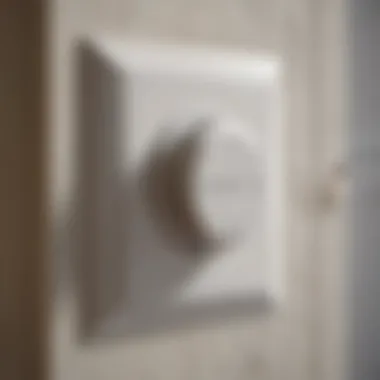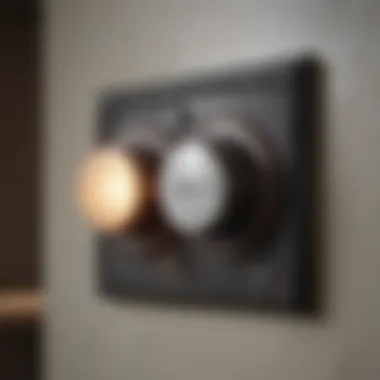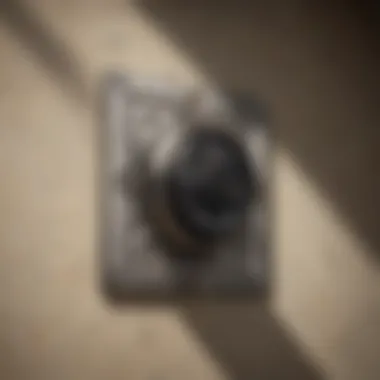Understanding Timer Light Switches for Bathroom Fans


Intro
Timer light switches for bathroom fans are becoming increasingly significant in modern homes. These devices are designed to automate the operation of exhaust fans, ensuring optimal ventilation without requiring constant manual intervention. Proper ventilation is crucial in bathrooms to prevent moisture buildup, which can lead to mold and mildew growth. An effective timer switch not only enhances air circulation but also contributes to energy efficiency.
Homeowners often find themselves questioning the practicality and functionality of these timer switches. Understanding their features, installation processes, and long-term benefits becomes essential for making informed decisions. This article offers insights into selecting the right timer light switch and addresses safety considerations and maintenance tips.
As you dive deeper into this guide, you will uncover the intricacies of utilizing timer light switches effectively, improving both bathroom air quality and energy conservation.
Prelude to Timer Light Switches
Timer light switches serve a crucial role in modern bathrooms, especially in managing fans. These devices automate the process of ventilation, helping to eliminate excess moisture and odors after showers or baths. Understanding timer light switches is essential because they contribute significantly to both comfort and energy efficiency in your home. This section lays the groundwork for exploring their definition, historical background, and importance in bathroom settings.
Definition and Purpose
A timer light switch is a specialized switch that controls the lighting or ventilation in a space based on a set time duration. In the context of bathroom fans, these switches allow the fan to operate for a predetermined amount of time after being manually activated or can be programmed to turn on and off automatically. The primary purpose of these devices is to manage humidity levels effectively, thereby preventing mold and mildew growth, which are common in bathrooms. Additionally, they contribute to energy savings by ensuring that the fan only runs when needed.
Historical Context
The evolution of timer light switches reflects broader trends in both technology and home design. In earlier times, ventilation was largely a manual process, with homeowners relying on windows or basic exhaust fans. As awareness of indoor air quality grew, along with concerns over energy efficiency, the demand for more sophisticated solutions emerged.
In the late 20th century, the introduction of electronic timers marked a significant advancement. These devices provided users with the ability to control their ventilation systems much more conveniently. Over the years, timer more programmable features have been integrated, allowing for more user customization, making them a staple in modern bathrooms. Understanding this historical backdrop helps reinforce the practicality and necessity of timer light switches in today’s homes.
Benefits of Timer Light Switches for Bathroom Fans
Timer light switches for bathroom fans provide multiple advantages that can significantly enhance the functionality and efficiency of bathroom ventilation systems. By properly integrating these timers into your bathroom setup, you can optimize energy use, control humidity levels, and add a layer of convenience to daily routines. Here, we will break down the key benefits of these devices, emphasizing their critical role in modern home environments.
Energy Efficiency
Utilizing timer light switches can lead to significant energy savings. Traditional bathroom fans often run continuously, which can lead to increased energy bills. With a timer switch, homeowners can set the fan to operate for a predetermined time after using the bathroom. This ensures that the fan runs just long enough to clear out moisture and odors without wasting electricity.
- Reduced Energy Consumption: By limiting the operational time of the fan, timer switches decrease power usage.
- Cost Effectiveness: Homeowners can enjoy lower utility bills, allowing for a more budget-conscious approach to home maintenance.
- Environmental Impact: Less energy consumption aligns with broader efforts to reduce carbon footprint and protect the environment.
"Smart energy management is not just a trend; it's a necessity in modern living."
Humidity Control
Humidity can cause various issues in bathrooms, from mold growth to damage to fixtures and finishes. Timer switches are effective tools for managing humidity levels. By controlling when the fan turns on and off, these devices help maintain a balanced environment that discourages excess moisture.
- Prevent Mold Growth: Running the fan for a set period after showering will help eliminate moisture, reducing the chances of mold and mildew developing.
- Promote Dry Conditions: Proper air circulation ensures that the bathroom dries efficiently, making it more comfortable and hygienic for use.
- Health Benefits: Lower humidity levels can also mean fewer allergens and irritants, which is important for families or individuals with respiratory issues.
Convenience
The addition of a timer light switch brings about great convenience in daily routines. Homeowners no longer need to remember to turn the fan off; it can be managed with a simple setting.
- Automatic Functionality: Users can set the timer based on their habits, allowing the fan to operate independently.
- Enhanced User Experience: Whether preparing for a shower or using the bathroom, knowing the fan will operate for the desired duration without manual intervention adds ease to everyday life.
- Customizable Settings: Many timer switches come with adjustable settings, allowing users to tailor the operation time to their specific needs.
Types of Timer Light Switches
Choosing the right type of timer light switch is crucial for optimizing bathroom ventilation. This decision affects energy consumption, ease of use, and overall performance. Different types of timer light switches cater to various needs and preferences. Understanding these distinctions empowers homeowners to select a switch that aligns with their requirements.
Digital vs. Analog
Digital timer switches boast advanced features such as programmable options, timers, and sometimes even touch screens. They allow for precise settings, enabling users to adjust durations and specific times for operation. This capability enhances control over bathroom fan usage, contributing to energy savings.
On the other hand, analog switches are straightforward and often easier to install. They typically use a dial or simple on/off switch, making them user-friendly. However, they lack the fine-tuning capabilities of digital models. The choice between digital and analog often comes down to user preference and how much versatility is desired in managing ventilation.
- Digital Advantages:
- Analog Advantages:


- High precision in settings
- Easier customization
- Possible integration with smart home systems
- Simplicity in design
- Affordability
- Straightforward installation
"Choosing between digital and analog timer switches depends on your specific needs and how you plan to use your bathroom fan."
Programmable Timers
Programmable timers are an excellent choice for those who want customized schedules for their bathroom fans. These timers allow users to set different operational modes for varying times of the day or week. For instance, fans can be programmed to run longer during peak usage hours, such as in the mornings or after showers. This flexibility helps in efficiently removing moisture, thus preventing mold growth.
Additionally, programmable timers can offer features like countdown timers, which automatically turn off the fan after a set period. This feature ensures that the fan does not run longer than needed, saving energy and reducing costs on electric bills. It is essential to consider the programming interface as well. A user-friendly design will simplify setting adjustments.
- Benefits of Programmable Timers:
- Flexibility in scheduling
- Enhanced moisture control
- Energy conservation through automated shutdown
Motion Sensors
Motion sensor switches provide a unique solution by automating fan operation based on occupancy. These sensors detect movement within the bathroom and activate the fan accordingly. This hands-free approach is particularly beneficial for households with many family members or for those who wish to avoid touching switches with wet hands.
The main advantage is that the fan remains operational only when the space is in use, optimizing energy efficiency. Additionally, many motion sensors allow for adjustment of sensitivity and timer duration, meaning you can personalize how they respond to motion. This ensures the fan runs just the right amount, providing ventilation while avoiding unnecessary energy use.
- Considerations for Motion Sensors:
- Sensor range and detection reliability
- Adjustment options for sensitivity
- Installation location for optimal performance
Selecting the Right Timer Switch
In the quest for optimal bathroom ventilation, choosing the right timer light switch is a central task that significantly affects both functionality and user experience. Each switch has unique features that cater to different needs; understanding these features helps in making an informed choice. The right timer switch can help utilize the bathroom fan more effectively, leading to improved air quality and energy savings. Investing time to review the options may save you from future frustrations and elevate your overall experience.
Voltage and Compatibility
When selecting a timer switch, voltage and compatibility are fundamental factors to consider. Most residential electrical systems use either 120 volts or 240 volts depending on the specific installation. The timer switch must match the voltage of your home to operate correctly. If you connect a switch designed for a lower voltage to a higher voltage source, it may lead to malfunction or even pose safety hazards.
Additionally, compatibility with existing wiring is important. Before purchasing, confirm whether the switch is suitable for your bathroom fan's configuration. Some fans may also require a specific type of switch due to their features, such as specific load ratings. Always review the product specifications to ensure a seamless installation.
User-Friendly Interface
A user-friendly interface is vital for optimal operation of the timer light switch. Homeowners often seek solutions that are intuitive and easy to operate. A switch with clear labeling and straightforward controls allows users to adjust settings without confusion. Look for devices with digital displays as they often provide more information at a glance.
Features like one-touch settings can enhance convenience. If the switch is challenging to operate, it negates some benefits it provides. Functions such as preset timing options and manual overrides add to the usability, ensuring that users can quickly adapt to their needs.
Design and Aesthetics
The design and aesthetics of a timer light switch may seem secondary to functionality, but they play an essential role in home decor. The switch should align with the overall style of the bathroom. Options exist that range from minimalist designs to more decorative units with added features like backlit displays.
A well-chosen switch contributes to a cohesive look within the space, subtly enhancing the room's ambiance. Additionally, materials used in the construction of the switch can affect durability and maintenance. Selecting a design that fits your aesthetic preference while being made of quality materials is an investment in both beauty and functionality.
"The choice of a timer switch can influence both ease of use and the aesthetic of your bathroom environment. Think of it as an essential component of bathroom comfort and style."
Installation Process of Timer Switches
The installation process of timer switches is an essential topic when discussing their functionality and advantages. Proper installation guarantees that the timer operates correctly and enhances the effectiveness of bathroom ventilation systems. Without adequate installation, one might face issues such as incorrect timing, malfunctioning of the fan, or even safety hazards. Thus, understanding the steps involved in this process is vital for homeowners aiming to maximize the benefits of their timer light switches.
Necessary Tools and Materials
Before starting the installation, ensure you have the right tools and materials. Here is a list to get you started:
- Screwdriver: A flat-head or Phillips screwdriver will work depending on the type of screws used.
- Wire Strippers: Useful for stripping the wires for the new switch.
- Voltage Tester: This device helps to confirm that power is off before commencing work.
- Electrical Tape: For securing connections and insulation.
- Timer Switch: The chosen model should be compatible with your bathroom fan.
- Wire Nuts: These are essential for joining wires safely.


Gathering these items beforehand simplifies the installation process and reduces the risk of interruptions.
Step-by-Step Installation Guide
Installing a timer switch involves the following steps:
- Turn Off the Power: Locate the circuit breaker for the bathroom and switch it off to ensure safety while working on the wiring.
- Remove the Old Switch: Unscrew and take out the old switch from the wall. This exposes the wiring behind it.
- Identify the Wires: Typically, you will see several wires: a line wire bringing power, a load wire connecting to the fan, and a ground wire. Make sure to note which wire corresponds to each function.
- Connect the Timer Switch:
- Insulate Connections: Once the connections are made, use wire nuts to ensure they are joined securely. Wrap them with electrical tape to prevent any exposure.
- Mount the Switch: Fit the new timer switch back into the wall and secure it with screws.
- Restore Power: Turn the circuit breaker back on and test the switch to ensure it operates correctly.
- Connect the line wire to the appropriate terminal on the new timer switch.
- Attach the load wire that goes to the fan.
- Secure the ground wire to the grounding terminal provided on the switch.
This straightforward process can typically be completed in under an hour, depending on one's familiarity with electrical systems.
Common Pitfalls to Avoid
While the installation process is fairly simple, some common mistakes should be avoided:
- Neglecting Safety: Always confirm the power is off before touching wiring. Using a voltage tester can further ensure safety.
- Incorrect Wiring: Double-check each connection to avoid miswiring, which can lead to malfunction or even damage.
- Rushing the Process: Take your time to follow each step carefully. Skipping steps can result in faulty installation.
- Failing to Read Instructions: Each timer switch may come with specific manufacturer instructions. Always refer to these before installation.
By adhering to these guidelines, the installation of a timer switch will not only enhance the functionality of your bathroom fan but also improve energy efficiency and ventilation. The focus on careful installation pays off long-term with better air quality in your bathroom.
Safety Considerations
Ensuring safety when installing and using timer light switches for bathroom fans is paramount. Bathrooms are typically environments with increased humidity, which can pose risks when dealing with electrical devices. A clear understanding of safety precautions can prevent accidents and enhance the overall functionality of the timer switch. By focusing on electrical safety and water resistance, homeowners can safeguard themselves and their families from potential hazards.
Electrical Safety Precautions
Before installing a timer light switch, it is critical to disconnect the power supply to avoid electric shocks. To do this, locate the circuit breaker and turn off the corresponding switch. It is advisable to use a voltage tester to confirm that the electrical current is indeed off before proceeding with installation.
Moreover, always use timer switches that are specifically designed for use in bathrooms. These switches often comply with strict safety standards, which should be reflected in their certification labels. Common certifications include Underwriters Laboratories (UL) and the International Electrotechnical Commission (IEC).
When working with electrical components, it is recommended to use insulated tools. This further minimizes risks associated with accidental contact with live wires. Additionally, be mindful of ensuring proper wire connections. Loose connections can lead to short circuits, creating potential fire hazards.
Water Resistance Ratings
Given the nature of bathrooms, water resistance is a crucial aspect of timer light switches. Water-resistant switches help mitigate the chances of electrical faults caused by moisture exposure. Look for products that have appropriate Ingress Protection (IP) ratings, which indicate their effectiveness against water and dust intrusion. For bathroom conditions, a rated switch should ideally have an IP65 score or higher.
Key Points to Consider:
- An IP65 rating means the device is completely dust-tight and protected against water spray from any angle.
- Ensuring the timer switch is rated for wet conditions can prolong its lifespan and minimize maintenance issues.
Adhering to electrical safety precautions and choosing water-resistant products enables a safer environment. This prioritizes care in using timer light switches effectively, ensuring both enhanced functionality and peace of mind for homeowners.
Maintenance of Timer Light Switches
Timer light switches play an essential role in managing the operation of bathroom fans. Like any electrical component, they require regular maintenance to function effectively. Proper maintenance ensures that the timer switches operate efficiently, which in turn maximizes their benefits, such as energy savings and humidity control. Neglecting this aspect could lead to decreased performance and potential malfunctions over time.
Regular maintenance not only extends the lifespan of timer light switches but also ensures safety in the bathroom environment. A well-maintained switch decreases the chances of electrical failures, which could pose safety risks. This section discusses the two crucial elements: regular inspection and troubleshooting common issues.
Regular Inspection
Regular inspection of timer light switches is crucial for early detection of any issues. Homeowners should consider performing inspections at least once a year. During an inspection, check the following elements:
- Physical Condition: Look for any signs of wear, breaks, or discoloration.
- Functionality: Test the switch to ensure it is operating as intended. Check that it properly controls the fan and turns on and off according to the set timer.
- Wiring Assessment: Inspect the wiring to ensure there are no loose or frayed connections. Loose wires can lead to inconsistent performance or even electrical hazards.
It's also a good idea to clear any debris that may have accumulated around the switch, as dust can impact performance. Keeping the switch clean helps maintain operational efficiency.
Troubleshooting Common Issues


Despite the best maintenance practices, problems may still arise with timer light switches. Understanding how to troubleshoot common problems can save homeowners from unnecessary replacements. Here are some common issues and their solutions:
- Timer Not Resetting: If the timer fails to reset, check the reset button or switch. Sometimes, a simple press can resolve the issue. If the problem persists, consult the user manual or contact the manufacturer.
- Fan Not Turning Off: This can result from a faulty timer or incorrect settings. Ensure that the intended timing is correctly programmed, and if the fan still won’t turn off, the timer may need replacing.
- Intermittent Operation: If the timer works sporadically, inspect the wiring and ensure proper connections. A loose wire could create inconsistent performance.
Ultimately, routine maintenance and timely troubleshooting can significantly enhance the performance and safety of timer light switches in bathrooms. Through diligence, homeowners can enjoy the multiple benefits these devices provide.
Leveraging Technology in Bathroom Fan Control
As homeowners become more aware of energy-saving solutions, integrating technology into bathroom fan control has become essential. Timer light switches represent a notable advancement, streamlining ventilation processes while enhancing user convenience. The convergence of technology with traditional setups offers various benefits. This section examines how smart systems and remote controls provide effective solutions for modern living.
Integration with Smart Home Systems
The advent of smart home technology has transformed the way we manage household functions, including bathroom ventilation. Integrating timer switches with smart home systems, such as Google Home or Amazon Alexa, allows for seamless control. Users can schedule fan operation through voice commands or mobile apps. This flexibility means you can adjust settings without physically accessing the switch. Additionally, connectivity to broader home networks can improve energy efficiency. For example,
- Adjusting fan runtime based on humidity levels detected by other smart devices.
- Coordinating fan activity with lights or heating systems for optimal operation.
Integrating timer switches into smart home ecosystems not only enhances functionality but also simplifies daily tasks.
Remote Control Options
The demand for remote control options in bathroom fan management is growing. Remote controls facilitate off-site operation, enabling users to manage ventilation from afar. Several timer light switches come with dedicated remote devices, making them versatile in different settings. Some newer models may support smartphone applications, giving users greater flexibility and control. Features might include:
- Scheduling - Set specific times for the fan to run, perfect for when you are not home.
- Adjustable Settings - Change fan speed or timer duration without needing physical access.
- Feedback Mechanisms - Programs notify users if the fan is running outside the usual parameters.
Utilizing remote control options furthers the goal of optimal bathroom ventilation tailoring functionality to individual needs and habits. Each advancement represents a response to the growing emphasis on convenience and efficiency in modern living.
Environmental Impact of Timer Switches
The examination of timer light switches for bathroom fans extends beyond their functional benefits. In an age where ecological considerations are critical, it is essential to scrutinize their impact on the environment. Utilizing energy-efficient technologies like timer switches can help lower energy consumption and, consequently, reduce greenhouse gas emissions. These switches provide a pathway for responsible energy use, stimulating interest in their broader environmental implications.
Reducing Carbon Footprint
The adoption of timer light switches significantly contributes to the reduction of carbon footprint. When these switches are employed, they ensure that bathroom fans do not run unnecessarily. This helps conserve electricity.
- Optimized Usage: With the ability to set timers, users can operate bathroom fans only when required. This optimizes fan usage without compromising air quality.
- Lower Energy Bills: By decreasing overall energy consumption, homeowners will notice a decline in their electric bills. This saving also translates to a decrease in overall energy production, which is often reliant on fossil fuels.
By cutting down on energy usage, not only do timer light switches benefit individual households, but they foster a collective endeavor to reduce carbon emissions on a larger scale.
Sustainable Materials
Beyond their operational advantages, the materials used in manufacturing timer light switches can also impact the environment. Many manufacturers focus on sustainability by utilizing eco-friendly materials.
- Recycled Components: Several timer switches incorporate recycled plastics and metals, alleviating the strain on virgin resources. This practice promotes responsible consumption and helps recycle existing materials.
- Durable Construction: High-quality materials lead to longer-lasting products. This minimizes waste, as fewer replacements are needed over time.
- Eco-Certifications: Many switches come with certifications indicating environmentally friendly production processes, which can help consumers make informed choices.
"Choosing timer light switches made from sustainable materials not only enhances efficiency but also aligns with a conscious lifestyle."
Epilogue: The Importance of Timer Light Switches
Timer light switches play a pivotal role in enhancing bathroom ventilation and overall home energy efficiency. By automating the operation of bathroom fans, these switches ensure that humidity levels are controlled effectively, which can significantly reduce the risk of mold and mildew growth. Moreover, timer switches provide convenience to users, eliminating the need to remember to turn off the fan after use. This functionality not only improves air quality but also saves energy by preventing the fan from running unnecessarily.
The discussion throughout this article highlighted various key aspects of timer light switches. They demonstrate technological advancement in home fixtures, promoting smarter home management. From improving energy efficiency to offering practical benefits, timer switches are an essential component in modern bathroom design.
Recap of Key Points
- Energy Efficiency: Timer switches optimize fan run time, reducing unnecessary energy consumption.
- Humidity Control: Automating fan operation helps eliminate excess moisture, preventing mold growth.
- User Convenience: Timers eliminate the need for manual operation, simplifying bathroom use.
- Integration with Technology: Smart timers provide advanced capabilities, such as remote control and compatibility with smart home systems.
"Timer light switches not only serve a basic function; they elevate the overall efficiency and comfort of bathroom environments."
Future of Bathroom Ventilation Technology
The future of bathroom ventilation technology looks promising. Innovations in sensor technology are leading to highly responsive systems that can adapt to real-time conditions. For example, moisture-sensing fan controls can activate only when humidity reaches a certain threshold.
Furthermore, the integration of timer switches with smart home systems is becoming more common. Homeowners can control their bathroom fans via smartphone apps, allowing for remote management and enhanced flexibility.
In summary, as technology develops, so too will the features and efficiencies of timer light switches. This presents exciting possibilities for improved air quality and energy conservation in the home.















